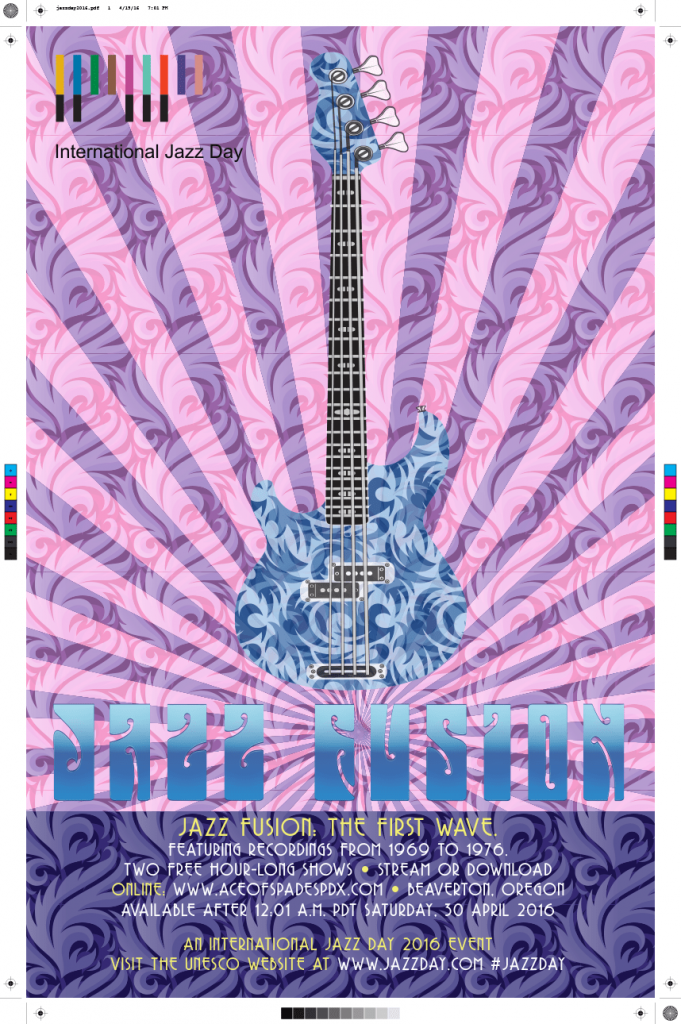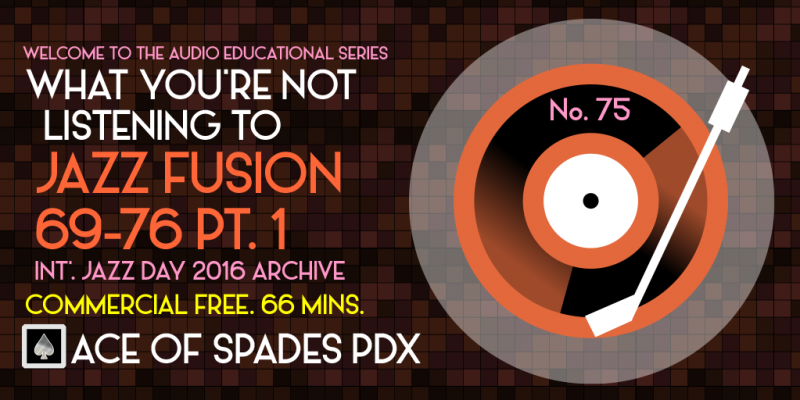Podcast: Play in new window | Download | Embed
The first of the two International Jazz Day 2016 promised to all of you I would start bringing out of the archives. #jazzday #JazzFusion #Jazz #JazzRock
Note: Biographical/historical information about each selection follows below the track listing.
Even though the seeds of what we now call the first wave of Jazz Fusion had been sewn for most of the 1960’s, it wasn’t until Bitches Brew by Jazz luminary Miles Davis was released in 1969 did the form first gain widespread notoriety. As with most immediate and radical departures of a signature sound, there were many who derided the genre, and in this instance, as pandering to rock audiences, regardless of the classic Jazz pedigree that many of the biggest names in this new music form carried. Oddly, unlike Jazz or Rock and Roll, the first wave of this hybrid was steadily developing among the Blues, Psychedelic and Progressive Rock scenes of England prior to gaining acceptance in the U.S.
To the uninitiated, the sound of Jazz Fusion is a heady mix of not just traditional Jazz and Rock and Roll, but often with elements of avant grade or Free Jazz sounds, and with some of these artists, an extension as well of R&B and the then newly emerging Funk sound. Most notably, Jazz Fusion is the sound of Jazz going completely electric; this also meant amplification and a volume at times that would rival many of the major heavy groups of the period. Additionally, Fusion brought new musical instruments into the realm of Jazz that were previously unheard of, such as the violin, the electric bass and synthesizers, sometimes at the expense of brass instruments, which had previously been a mainstay.

Regardless of the derision by so-called “purists”, Fusion also brought Jazz music and Jazz musicians onto stages typically only reserved for the most successful Pop and Rock acts for the first time in United States.
First Part
- School Days, 1976, Stanley Clarke, School Days
- Joy Ride, 1974, Eleventh House, Introducing the Eleventh House with Larry Coryell
- Jadoo, 1975, Passport, Cross Collateral
- Passenger In The Dark, 1976, Jean-Luc Ponty, Aurora
- Yours Is The Light, 1973, Santana, Welcome
Second Part
- Meeting Of The Spirits, 1971, Mahavishnu Orchestra, Inner Mounting Flame
- After The Cosmic Rain, 1973, Return To Forever, Hymn Of The Seventh Galaxy
Finale
Chameleon, 1973, Herbie Hancock, Head Hunters
Biographical/Historical Info Pt. 1
First Part
- School Days, 1976, Stanley Clarke, School Days
Philadelphia native Clarke was one of the founding members of Return to Forever, one of the original wave of Jazz Fusion groups. This song was the title track from Clarke’s fourth album was the bridge between first wave Jazz Fusion and a second wave, which incorporated more R&B and funk influences into the mix. Clarke was an innovator of the electric bass in jazz Fusion, and you can hear it’s prominence on this track.
- Joy Ride, 1974, Eleventh House, Introducing the Eleventh House with Larry Coryell
This is a track from the debut album by Eleventh House. They are considered, along with Return to Forever and The Mahavishnu Orchestra to be one of the original Jazz Fusion groups. The band has a short discography, but along with Larry Coryell, Eleventh House also launched the career of drummer Alphonse Mouzon.
- Jadoo, 1975, Passport, Cross Collateral
This band was formed in Germany in 1971 by saxophonist Klaus Doldinger. The group, like so many other Jazz groups, have had a revolving membership, but are still active to this day. This track is from their fifth studio album, Cross Collateral, and was their first charted LP in the U.S.
- Passenger In The Dark, 1976, Jean-Luc Ponty, Aurora
Hailing from the Normandy region of France, Ponty originally was a classical violinist, until he discovered Jazz music in Paris. His instrument of choice is truly unique for a Jazz group of any flavor, which is the violin. Among his resume credits are The Mahavishnu Orchestra, Frank Zappa, Elton John; on his 1991 album Tchokola, he blends Jazz Fusion with West African musicians.
- Yours Is The Light, 1973, Santana, Welcome
Arguably the best known of all the acts in this program, the album on which this track appears, Welcome, signaled a complete change in musical style for the Santana band, which started on their previous LP, Caravanserai. The lead vocals on this tracks are by Flora Purim, who will will hear more from in the second part. Within a year, Carlos Santana, their leader and a man originally from Jalisco, Mexico, would also record an album with John McLaughlin of the Mahavishnu Orchestra entitled Love, Devotion and Surrender as a tribute to John Coltrane.
Second Part
- Meeting Of The Spirits, 1971, Mahavishnu Orchestra, Inner Mounting Flame
Founded by Englishman John McLaughlin, a veteran of a series of Jazz Fusion albums by Miles Davis, the Mahavishnu Orchestra truly put a heavy emphasis on the Rock and Roll aspect of Jazz Fusion. The group would also spawn several famous alumni, including Jan Hammer and Billy Cobham. The group was so popular among rock fans that even Aerosmith opened for them in the early 1970’s.
- After The Cosmic Rain, 1973, Return To Forever, Hymn Of The Seventh Galaxy
This is a track from the group’s third LP, Hymn of the Seventh Galaxy. Chick Corea, the groups founder, had played, like so many artists in this first wave of Jazz Fusion, with Miles Davis at the start of his electric period. Interestingly, three of the groups members during this period, Corea, drummer Lenny White and and bassist Stanley Clarke, also played on Chaka Khan’s 1982 Jazz LP Echoes of an Era.
Finale
- Chameleon, 1973, Herbie Hancock, Head Hunters
This track, from Hancock’s twelfth album, Headhunters, is a signature release among Funk music being an integral part of Jazz Fusion. Hancock brought a pedigree in classic, traditional Jazz that few were able to match, and caused many of the naysayers to take a second look at a genre they had previously been critical of. In 2007, this recording was added to the Library of Congress.
Love to you all.
Ben “Daddy Ben Bear” Brown Jr.
Host, Show Producer, Webmaster, Audio Engineer, Researcher, Video Promo Producer and Writer
“Copyright Disclaimer Under Section 107 of the Copyright Act 1976, allowance is made for ‘fair use’ for purposes such as criticism, comment, news reporting, teaching, scholarship, and research. Fair use is a use permitted by copyright statute that might otherwise be infringing. Non-profit, educational or personal use tips the balance in favor of fair use.”
